Bikaner, tucked away in the state of Rajasthan, is a vibrant and vintage city that is surrounded on all sides by a large stretch of golden sand dunes. This historical city is located amid the Thar desert, and it is embellished with enormous and stunning forts and palaces that attract thousands of visitors from all over the world.
In 1488, Rao Bika, a prince of the Rathore dynasty, reigned over this section of the country, and the older part of the city still remains as a mute monument to the region’s illustrious past. Bikaner is a popular destination for anyone looking to do some shopping. You will have a difficult time deciding between the exquisite glass work and the charming mojris (traditional shoes) together with the pottery.
How To Reach Bikaner?
By Air
The airport closest to Bikaner is the Jodhpur Airport, which is linked to many important cities. It is around 251 kilometres from the city. Taxis and buses are easily available from Jodhpur to Bikaner.
By Rail
Bikaner has two railway stations, the Bikaner Junction and the Lalgarh Railway Junction. These are linked to several important cities, including Jaipur, Punjab, Delhi, Hyderabad, and Mumbai. You can simply hail a cab from any of these two terminals to Bikaner.
By Road
Car travel from Jodhpur to Bikaner takes roughly 5 hours, whereas driving from Delhi to Bikaner should take around 1o hours. Choose the one that works best for you. You should absolutely consider taking a road trip to Bikaner if you haven’t already. In general, the city’s roadways are in excellent shape. There are hotels and resorts all the way to the destination, so you may stop and resume your trip whenever you choose.
15 most popular places to visit in Bikaner
The following are must-see Bikaner tourist places, all of which are favourites among visitors.
Rampuria Haveli
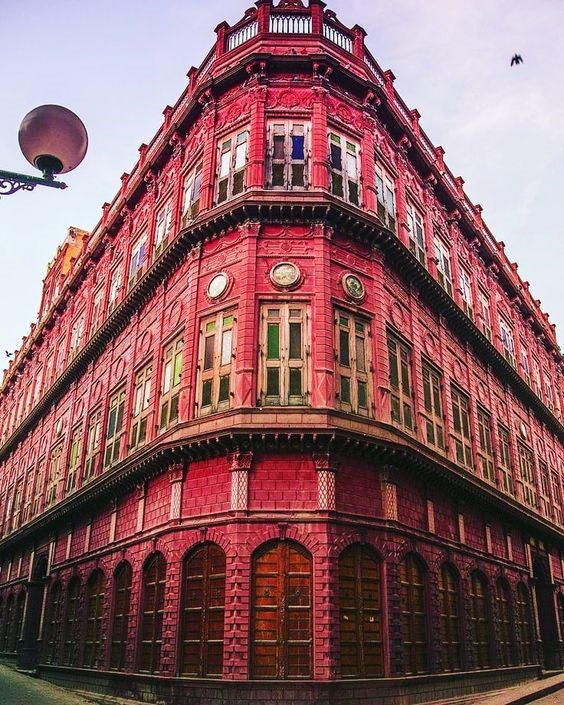
Source: Pinterest
One of the greatest Sci-fi writers, Aldous Huxley, once referred to the Rampuria Haveli as “the glory of Bikaner.” His remark, which he made after his excursion to the Rampuria Haveli, was entirely justified on account of the haveli’s age, grandeur, and exquisiteness. To begin, Rampuria Haveli was built in the 15th century by Balujee Chalva, who was given the command to construct regal and exquisite houses that suited the rich merchant family. Balujee Chalva’s work can be seen now in the form of Rampuria Haveli.
The lavish inner halls and rooms of the Rampuria Haveli are decorated and beautified with aesthetically pleasing art objects, first-class landscapes and portraits, and artefacts made from fine wood. In the drawing room of the Rampuria Haveli, a really awe-inspiring and spectacular fusion of not only Mughal and Victorian architecture but also Rajputana architecture can be found. Each of the seven havelis has its own name, but together they are referred to as the Rampuria Haveli.
Junagadh Fort

Source: Pinterest
One of the popular places to visit in Bikaner, the Junagarh Fort is a spectacular edifice that served as the focal point for the development of the city as it expanded outside. The name Chintamani was given to the fort when it was first constructed, but in the 20th century, it was renamed the Junagarh or Old fort. In 1478, Bika Rao laid the groundwork for the fort that would become known as Junagarh.
A fusion of architectural styles can be seen throughout the inside of the fort, including the gardens, balconies, kiosks, and palaces. This style was created as a result of the many cultural influences that were brought in by the various kings. The exceptional monuments that are on show within the fort date back to the late 16th century and represent 16 different generations of monarchs in the city of Bikaner.
Timings: 10 AM to 4:30 PM
Entry fees:
- Rs 50 for Indians
- Rs 30 for Indian students
- Rs 300 for foreigners
- Rs 150 for foreigner students
Gajner Palace

Source: Pinterest
The Gajner Palace in the city of Bikaner is situated on the banks of the Gajner Lake. This majestic castle was originally constructed by Maharaja Ganga Singh as a hunting lodge. In 1976, however, the palace was transformed into a hotel. You can choose from many fun activities, such as desert safaris and boat trips, while you stay at Gajner Palace. The whole surrounding area is covered in thick forests of lush trees, and the magnificent castle itself has a variety of amusements for guests, such as billiards, cycling, and wildlife safaris.
The historical hunting resort has relics of a nearby train station in its past. In the year 1922, a connection was made between the lodge and the train. The walls of Gajner Palace are still covered with art and legacy, even though the palace has undergone modernisation. The city of Bikaner takes great satisfaction in the cuisine it serves, the warmth and welcome it provides to visitors, and the dynamic cultural atmosphere it maintains. Since Bikaner is located in an area that is a part of the Great Indian Desert, there are a variety of desert-related activities available, including camel rides and safaris.
Timings: 9 AM to 8 PM
Entry fee: Rs 100
Lalgarh Palace
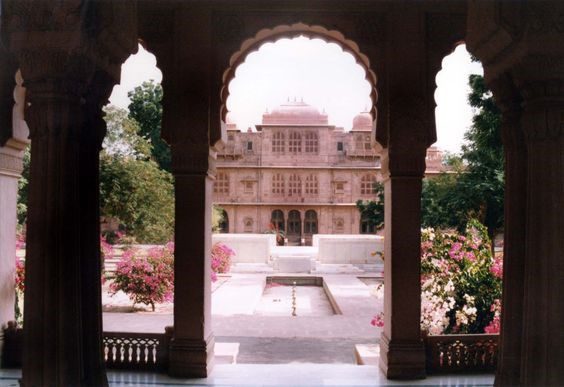
Source: Pinterest
The Lalgarh Palace was built between the years 1902 and 1926 for Maharaja Ganga Singh. The National Heritage Trust currently manages the whole estate, which includes the palace, which was constructed in the manner of European architecture. The palace is now available to the public as a hotel called the Heritage Hotel. In addition, the estate is home to a museum known as the Shri Sadul Museum. Here, you can discover artefacts belonging to the royal families of Rajasthan and learn about the opulent way of life they had.
If you choose to stay at the Lallgarh Palace Hotel, you will be blown away by the enormous size of the rooms you are provided with, as well as the royal hospitality that is shown to you throughout your time there. The royal family of Bikaner enjoys exclusive use of one of the wings of the estate, which has been kept for them. You can take a stroll around the magnificent hallways, go for a walk in the garden outdoors, or go for a swim in the pool after that.
Timings: 10 AM to 5 PM; Monday to Saturday
Entry fee: Rs 10 for Indians and Rs 20 for foreigners
Camel Festival
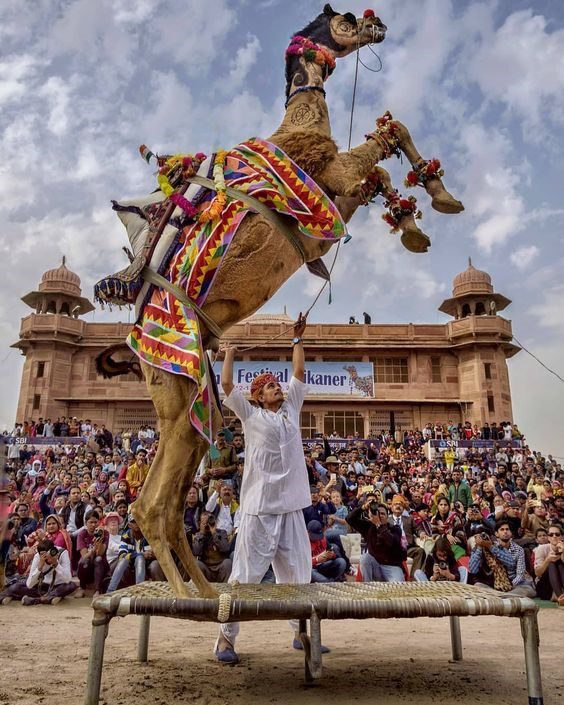
Source: Pinterest
The Department of Tourism, Art and Culture of Rajasthan puts on Camel Festival every year in the city of Bikaner in the month of January. When compared to other festivals in Rajasthan, this fair is among the most well-known celebrations. The majority of the event consists of camel-related spectacles, such as camel dances, camel racing, neck-shaking camel rides, and other such activities.
The festival kicks out with a colourful camel procession through Junagarh Fort, which serves as the perfect background for the celebrations. You’ll be awed by the colourful bridles, traditional necklaces, and hefty anklets of the camels as they show off their impressive footwork in the desert. It’s also a great opportunity to see camel races, games, and other cultural activities. Visitors and locals alike are intrigued by this annual celebration. Enjoy the pleasant atmosphere to the fullest.
Royal Cenotaphs
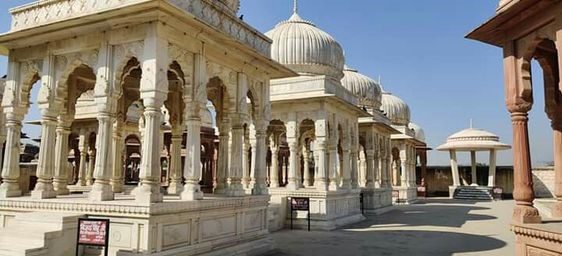
Source: Pinterest
Cenotaphs can be thought of as monuments or graves that are built in honour of significant individuals. They are in almost every city and town in the state of Rajasthan, although the ones in Jaipur, Jaisalmer, and Udaipur get the most attention from tourists. The magnificent cenotaphs in Bikaner have marble pillars with elaborate carvings that depict the story of Lord Krishna along with other gorgeous motifs from ancient art.
The most recent cenotaph was constructed for Maharaja Karni Singh. It is fascinating that each of the more than seventy cenotaphs that are dispersed around the Kalyan Sagar tank each has its own unique design and set of attributes. The chhatris are not only used to differentiate between genders and positions via architecture but also between different rulers through differences in design, size, and features.
Laxmi Niwas Palace
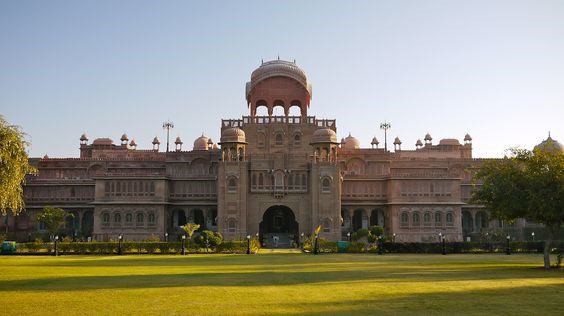
Source: Pinterest
The construction of Laxmi Niwas Palace took place in the years preceding World War-I, which was a period that was distinguished by economic success, creative expression, and political intrigue. The Laxmi Niwas Palace was commissioned by Maharaja Ganga Singh to serve as his royal abode. Construction on the palace took place between the years 1898 and 1902. The Indo-Saracenic architectural style was quite popular in India throughout the 19th century, and Sir Samuel Swinton Jacob was responsible for the design of the Laxmi Niwas Palace.
The Maharajah was known for his exceptional capacity for hospitality, and he hosted a long list of notable figures and dignitaries, including King George V and Queen Mary, the King of Greece, viceroys, and other Maharajahs, and prominent politicians. Laxmi Niwas Palace was transformed into a spectacular luxury hotel just before the beginning of the 21st century. The hotel honours the palace’s important legacy by keeping many of its historical features in their original locations.
Timings: 10:30 AM to 5:30 PM; Tuesday to Sunday
Compulsory Entry fee at the Palace’s gate: Rs 200 per person
Besides the compulsory fee, you will have to pay:
Indians: Rs 40 for adults and children
Foreigners: Rs 150 per person
Group Tours (including 20 students): Rs 400
Kodamdesar Temple
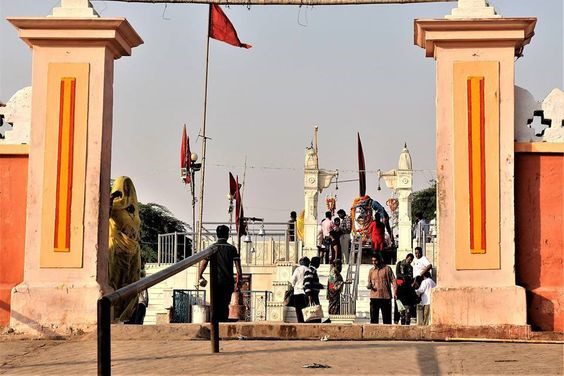
Source: Pinterest
The Kodamdesar Bheruji Temple was built by Rao Bikaji, the man who founded the city of Bikaner. An incarnation of Lord Shiva, Lord Bhairon Ji is honoured in the Kodamdesar Temple. The Kodamdesar Temple was one of the earliest buildings that Rao Bika ever built, and it is now a fascinating destination for tourists. The Temple does not include any rooms or doors; hence it is totally open. The only thing that can be found in the centre is a massive idol of Bhairo Ji. The floor is entirely constructed out of white marble, and the area behind the temple has a pond.
This temple serves as the venue for the annual Bhadrapad Fair, which attracts a large number of skilled artists and craftspeople from the surrounding area. Couples who have just tied the knot go to the temple to pray for the Lord’s blessings. Additionally, newborn infants are brought in during the Mundan rite (first hair-shaving ceremony).
Karni Mata Temple
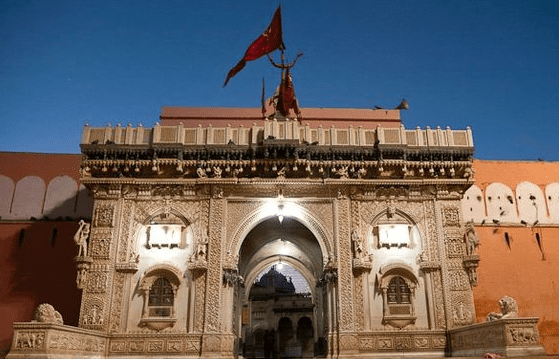
Source: Pinterest
The Karni Mata Temple, also known as the Nari Mata Temple or the ‘Rat Temple,’ is a temple in Rajasthan that dates back 600 years and can be found in the little hamlet of Deshnoke, which is around 30 kilometres away from Bikaner. One of the things that makes this temple stand out from others is the fact that it is home to 25,000 black rats, who are also venerated there. In point of fact, the food that is consumed by them is regarded as sacred and is then distributed to others as “prasad.”
People from all over the globe travel vast distances to come and pay their respects to these holy rats, which are referred to as kabbas, and they do so by paying a visit to the temple where they are housed. Although many myths and stories surround the temple and the rats who call this place home, no one knows the precise history of this one-of-a-kind sanctuary.
The Kote Gate
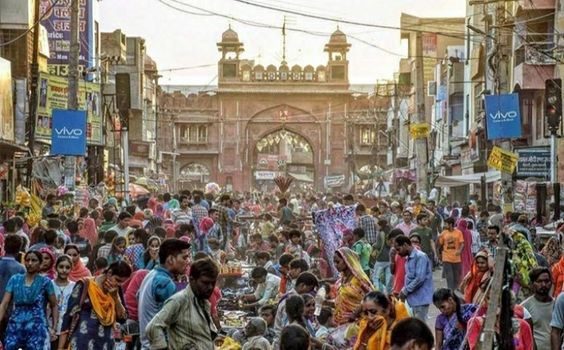
Source: Pinterest
The Kote Gate, which is regarded as the primary entry to Bikaner, combines a variety of architectural styles to provide visitors with a view of the ancient city. This intimidating tower is evidence of the skilled craftsmanship of artisans from bygone eras and is an impressive example. The towering Kote gate, seen in the centre of the road in Bikaner, serves as a boundary between the old and modern cities.
Shopping in the bazaar, which is situated close to the Kote gate, is consistently ranked as one of the most popular things to do in the area. In this market, some incredible items are available for purchase. Accessories made from camel leather and open-toed shoes are among the items that you really must get. Other goods that can be purchased here include miniature paintings, handicrafts, and products made from Khadi fabric, such as kurtas, wooden sculptures, and more. In addition, if you get weary, there are a variety of eating joints where you can purchase local delicacies such as Bikaneri sweets, Bikaneri bhujia, tea produced from camel’s milk, and so on.
National Research Centre on Camel
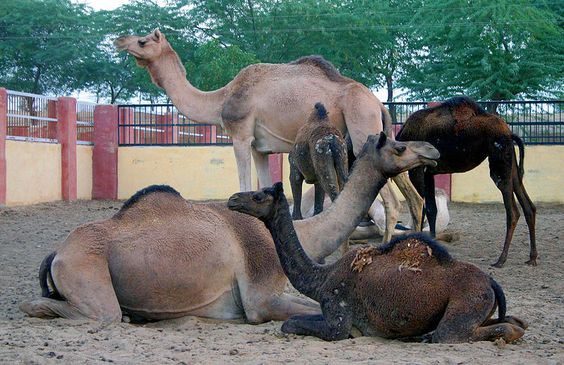
Source: Pinterest
The National Research Centre On Camel, which has been one of the most significant destinations in Bikaner, is available to visitors from afternoon till evening. The camel is a crucial component of the delicate desert ecosystem. It has become a symbol of adaptation to difficult ways of life in arid and semi-arid settings due to its unique bio-physiological traits. Tourists get the opportunity to see several camel breeds as well as their behaviour in this popular research centre.
Camel riding, going on safari, and videography and photography opportunities are also available here. The speciality of the centre is its camel milk parlour, where you can indulge in camel milk goods with their own distinct value additions, such as camel milk ice cream and camel milk hot and cold drinks. The location is only 8 kilometres from Bikaner, and it is possible to get there within an hour, depending on your mode of transport.
Timings: 2 PM to 6 PM
Entry Fees: Rs 30 for Indians and Rs 100 for foreigners
Camera fees: Rs 50
Ride Fees: Rs 50
Bhandasar Jain Temple

Source: Pinterest
One of the 27 stunning Jain temples that can be seen in and around Bikaner is the Bhandasar Jain Temple. This temple is dedicated to Sumatinath, the fifth Tirthankara; in addition, it is often regarded as being the most beautiful and the tallest temple in the world. It was constructed in the 15th century, making it one of the oldest temples in the city of Bikaner.
Mirror work, frescoes, and leaf paintings are used as decorations in this space. The structure of the temple is made of red sandstone, and it has a total of three levels. By ascending to the highest level of this temple, visitors would be able to have a view over the city of Bikaner. It is widely held that the temple was constructed not with mortar but rather with 40,000 kg of ghee. On hot days, people say that the ghee seeps through the walls of the temple.
Hotel Basant Vihar Palace

Source: Pinterest
This historical hotel in Bikaner, which is also a state-of-the-art facility, provides all of the modern conveniences that are necessary to make the visitors’ stay both comfortable and enjoyable. Hotel Basant Vihar Palace has an inviting combination of modern allure and classic architecture. When one is inside these rooms and stands near the window, they will get a wonderful view of the pool outside.
In addition to this, the interiors of these apartments are magnificent and give an atmosphere of tranquillity due to the soft furnishings. The hotel has a restaurant that serves a variety of delectable cuisines that are sure to tantalise the visitors’ taste buds and leave them wanting more. In a nutshell, the Hotel Basant Vihar is an ideal place to stay for travellers who are looking for a combination of elegance and comfort on their trip to Bikaner.
Kolayat Lake
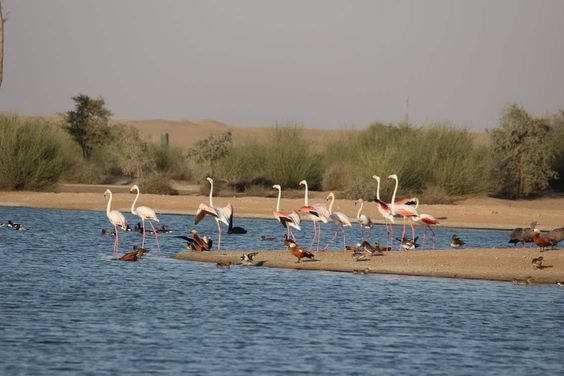
Source: Pinterest
The sacred Kolayat lake is located 51 kilometres away from Bikaner in a modest village that bears the same name. People continue to come here because, from a religious point of view, it is considered holy to take a dip in one of the Kolayat lakes. There are several ghats for swimming in this area, and peepal trees can be seen everywhere around them. Despite its arid climate, locals refer to it as the desert’s “beautiful garden.”
The Kolayat Fair takes place once per year and brings a lot of visitors to the town. Kapil Muni is credited with the creation of this lake, which he did to free his mother. It is believed to have been named after Kapi since it is a destination on the Kapi pilgrimage route. People have faith that the holy waters of Lake Kolayat can cleanse them of their sins. The area around lake Kolayat is covered with peepal trees which contributes to the overall ambience being more lovely and alluring.
Desert Safari

Source: Pinterest
Desert Safari in Bikaner is an exciting adventure that everyone should do at least once in their lives. It is a rocky journey. There is a large number of companies that can organise both desert camel safaris and jeep safaris. It is possible to experience the many ways of life, cultures, forts and castles, cuisines, desert safaris, traditions, secrets, and legends, among other things.
The Thar Desert is home to many different kinds of lizards, snakes, and deers, as well as the Great Indian Bustard, Blackbuck, and Indian Gazelle. This makes for a diverse safari experience. The sunset is breathtaking, and there are not enough adjectives in the English language to adequately depict the surrounding scenery. In the middle of the vast desert, visitors can enjoy live music and traditional dances.
FAQs
What's the best time of year to go to Bikaner?
During summer, Bikaner is prone to hot winds and dust storms. The best time to visit Bikaner is between October and March. The coldest months of the year are December through February, where the temperatures drop as low as 4 degrees Celsius.
What are my options for getting about Bikaner?
Due to the city's small streets and frequent sand storms, rickshaws, cars, and tongas are the most common mode of transportation. From the railway station, you can also rent a bicycle.
Where can one find the best eateries in Bikaner?
Suraj Restaurant, Chhotu Motu Joshi Sweet Shop, Heeralal, Gallops, and Laxmi Niwas Palace are considered to be the city's finest dining establishments.
What are the best locations to go shopping?
Kote Gate, Station Road, and City Shopping are three of the best areas to go shopping in Bikaner.
How many more days do you recommend spending in Bikaner?
A trip to Bikaner and exploration of the city can be completed in around two days. On your first day there, you can cover some of the most famous landmarks, such as the Gajner Palace, the Lalgarh Palace, and the Junagarh Fort.






